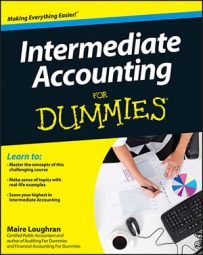A company doesn’t always buy an existing building in which to set up shop. Sometimes a company builds a factory or office building to its precise specifications and needs. Ditto for equipment. If the manufacturing process is unique, the business may have to construct some of its processing equipment.
The cost of self-constructed assets includes direct labor and material and overhead costs. It also generally includes interest on funds borrowed for the construction. Here’s some info about each of the four costs:
Direct labor: This expense includes only what the company pays to workers who are directly involved in constructing the assets.
Direct materials: These materials are the building materials, supplies, and other items a company buys to make the self-constructed assets.
The cost for direct labor and materials is usually a no-brainer; the company has material and supply invoices and worker payroll information to substantiate the costs that directly tie to the self-constructed assets.
Overhead costs: Also known as indirect costs, overhead includes all costs tied to making the self-constructed assets, except those you include in direct materials and direct labor. It also includes indirect labor and materials.
An example of indirect labor is a supervisor who oversees the construction of more than one asset. Indirect materials are nails or other fasteners that the company buys in bulk and uses for many different projects.
If allocated overhead is higher than the cost an outside vendor would charge for the same work, the excess goes to period losses (income statement) and isn’t capitalized as a cost of the asset.
Interest: Depending on the type of assets, a company may not have spare cash to pay for direct labor, material, and overhead costs.
If the company borrows money to pay for costs related to constructing the asset, GAAP states that actual interest expense incurred during construction is capitalized — that is, added to the basis of the asset instead of used as an expense on the income statement.
The capitalization period for interest begins when purchases for the assets have already been made, when the company has started gearing up to get the self-constructed asset process going, or when the interest cost is being incurred. The capitalization period ends when the asset is substantially finished and ready for use.
Profit or loss on self-constructed assets isn’t reported until the asset is sold. Even though Joe’s didn’t take the discount, you still have to reduce the cost of materials and supplies by the amount of discount lost.
PP&E also includes furniture and fixtures, examples of which are desks, chairs, and filing cabinets. Add to these three common examples any other furniture items you see in an office setting: credenzas, conference tables, area rugs — the list goes on and on. Fixtures include glass display cases and floor or wall display racks. Mannequins are also considered fixtures and, depending on their quality, can be a high-dollar item on the balance sheet.
PP&E’s related account, depreciation, has a whole chapter devoted to it in this book. Depreciation is how you move the cost of using the PP&E from the balance sheet to the income statement.

